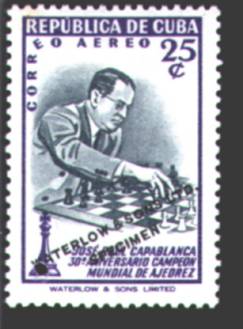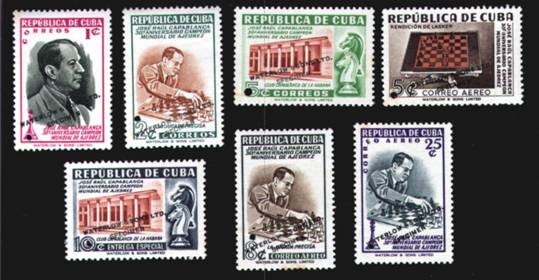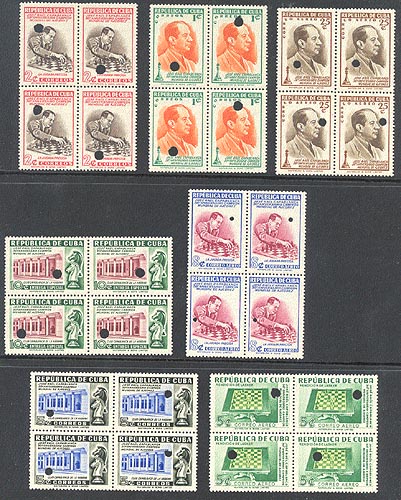

These beautiful proofs of the first Cuba chess issue of 1951 are not collected by everyone because they are expensive ($1,200-1,600 US for a complete set) and they rarely appear for sale.
Expensive, and hard to find. But are they legitimate?
The German Henninger catalogue includes them with the following remarks:
1. overprint (20º angle) with the words “waterlow & sons ltd” below the text “specimen”
2. coloring of some of the stamps is different than the original issued stamps
3. a small 1-2 milimeters hole is punched in the lower left part of each stamp
4. the 25c stamp has a different stamp-image then the originally issued stamp.
Here is an image of the whole set:

Five years ago, one of us (JE) purchased a pair of the 25c specimen for $160. In addition to the stamps, the seller provided considerable information about the specimens themselves.
From "Waterlow sample Stamps" by Marcus Samuel, in THE ESSAY-PROOF Journal No. 109, 1971
"Early in 1968, the Private Treaty Department of Robson Lowe Ltd was entrusted with the disposal of a large stock of stamps which had been prepared by Waterlow & Sons Ltd (who had ceased producing postage stamps by that time) for use as samples of their work when they were attempting to secure printing contracts. The great majority of these stamps took the form of proofs printed in colors and with line perforations WHICH WERE NOT USED FOR THE ISSUED STAMPS; they were nearly all overprinted "WATERLOW & SONS LTD./SPECIMEN" (in a large number of different types) and punched WITH SMALL HOLES as an additional measure of security. The paper was nearly always UNWATERMARKED SOFT WOVE and was frequently ungummed."
"The stamps were contained in a series of envelopes, on the fronts of which were inscribed in manuscript the firm's reference numbers for the stamps they contained, prefixed by the letters "S.T." (the significance of which remains unknown) and to which were affixed single examples of the stamps they contained, generally imperforate and unpunched, with and without overprints, in the latter instance defaced by scratches or pen strokes...
"Until the discovery of this stock in 1968, it had not been appreciated that so wide a range of stamps had been printed in unissued colors for use as examples..."
Samuel emphasizes that these stamps are technically REPRINTS rather than color proofs made before or at the time of the issued stamps. A study of the reference numbers suggests that the stamps may have been printed soon after the issue stamps... still, he concludes that it is not inappropriate to call them as proofs... but not as "color trials."
There are many plate varieties, perforation and overprint varieties... some waterlow sheets escaped perforation, and some were left unpunched. Overprints may be found omitted, inverted, or double... and a few experimental sheets bear more than one type of overprint.
The Robson Lowe sale appeared in one ad in Lynns on April 22, 1968. Their catalog states that in 1968, Robson Lowe Ltd were instructed to sell a wonderful "find" of these sample stamps ... there are 18 overprint typefaces and they are mostly punched with small (not large) holes...
The Cuban set sold for $43.50 a set... blocks of four were available for the 1c, 2c, 5c, and 10c. Purchases were limited to four sets (or one block of 4)/ person.
Just one ad, but Robson Lowe sold out quickly!
Sanabria’s Air post catalogue of New York 1957 mentions the Cuba proofs. Only the three airmail stamps (5C, 8C, 25C), but no wonder, it’s an airmail catalogue….
This catalogue mentions that; proofs exists with changed colours (5C dark-brown and red, 8C dark-green and brown, 25C purple and blue-grey). No further details.
Nico wrote this article because a USA stamp dealer offered a series of so-called proofs of Cuba 1951 with the large holes in blocks of 4 ....for a total of USD 350.
Seemingly, an impossibly wonderful price.
Below the scan of his stamps:

Very nice, but are they real or forgeries? Any one could have perforated the stamps. As the secretary of the Belgium Chess Collectors wrote: “My daughter also has a perforator!”
Note that the stamps with the large holes have no o/p with Waterlow & Sons. Most important, perhaps, the colors on these “proofs” should deviate from the color of the original issued stamps. However, the ones shown are exactly equal to the common 1951 ones, including the key 25C stamp image.
There are many forgeries through time. Our conclusion: a forgery for sure. Each of us independently contacted the dealer about this. He never mentioned that others had contacted him. He played the innocent at first and after gentle reminders (including the information in this article), he stopped responding.
Beware of such “bargains.”